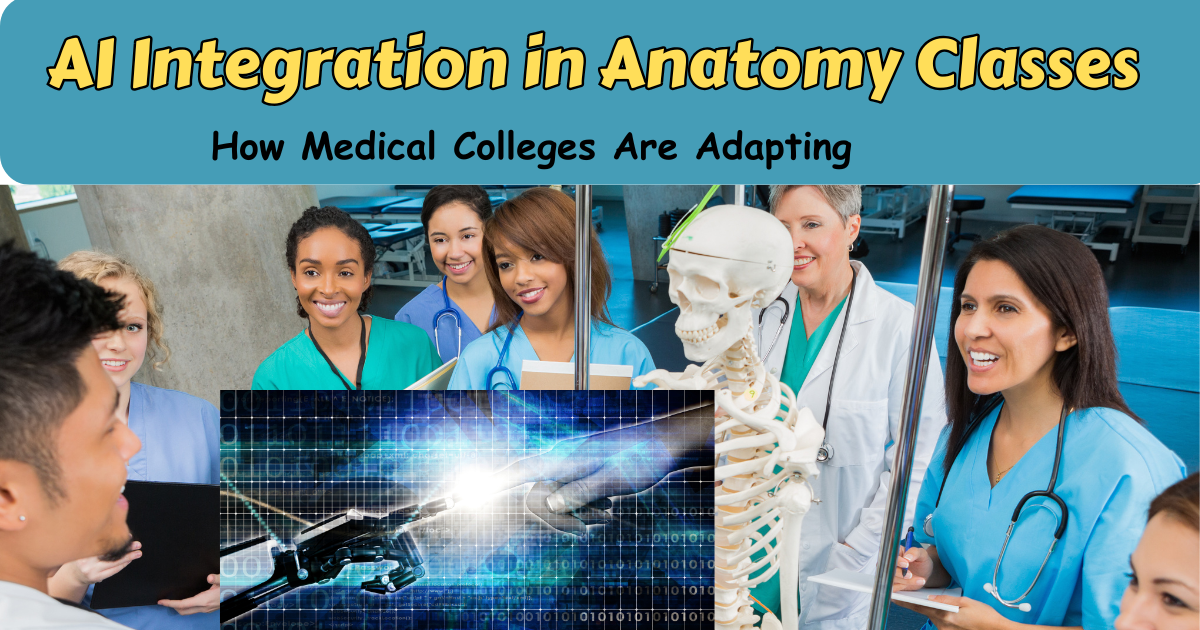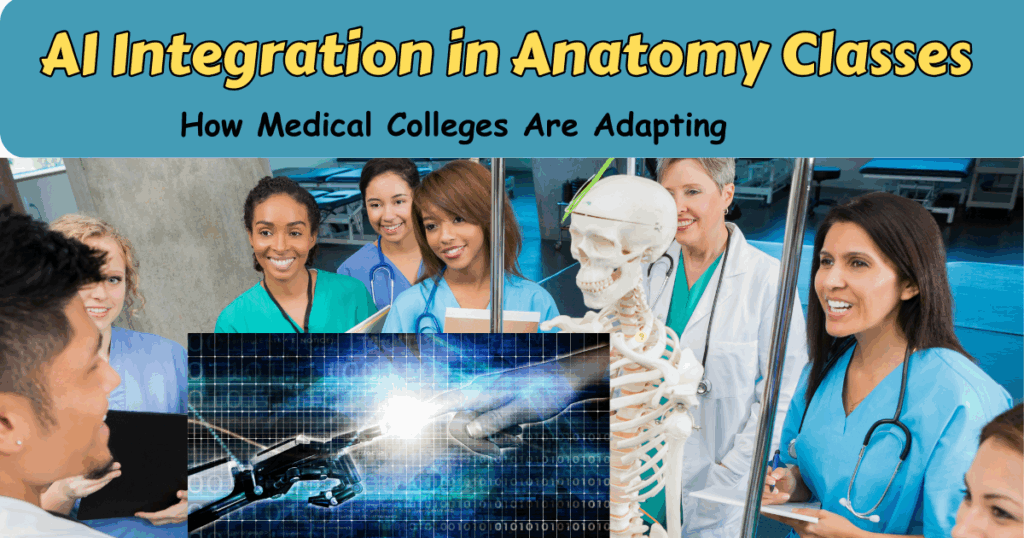AI Integration in Anatomy Classes – How Medical Colleges Are Adapting: Medical anatomy is an essential course for medical undergraduates and provides a fundamental basis for various medical and surgical specialisations. Frequently, students encounter difficulties when it comes to studying and comprehending the subject matter.
AI Integration in Anatomy Classes
Anatomy education is a cornerstone of medical training and provides the foundational knowledge essential for accurate diagnoses, safe surgical interventions, and effective interpretation of medical imaging.

Current students have extensive digital technology exposure during all phases of pre-tertiary education and are habituated to succinct video-based information browsing, posing a challenge to tertiary-level educators in meeting the attention and engagement requirements of the generation.
Integrating artificial intelligence (AI)-generated resources into anatomy education has emerged as a promising solution to address these challenges and align with modern educational demands. AI refers to the use of computer algorithms and machine learning techniques to simulate human cognitive functions, which can then be used in the generation of text, images, language, and education, as evidenced by its use in ultrasound-guided anatomy training.
Artificial intelligence (AI) is a groundbreaking technology that can impact multiple domains, including medical education. Recently, there has been significant interest in integrating AI into educational environments, as educators and academics explore the potential of advanced technology to enhance learning.
AI-driven technologies have the potential to revolutionize anatomy teaching by offering customized learning paths, adaptive testing, and sophisticated visual aids.
Artifical intelligence technologies in anatomy education
The integration of AI in anatomy education has given rise to a range of innovative applications and tools that can enhance the teaching and learning process. A study by Abdellatif analyzes how AI might improve anatomy education, teaching, and assessment.
It emphasizes the necessity for new techniques to increase student knowledge and recall of anatomy due to its complexity and breadth. The study underlines AI’s ability to store, analyze, and use massive amounts of data to personalize learning, improve accessibility, and boost engagement through interactive lessons and VR.
How is artificial intelligence used in medical education?
In medical education, AI encompasses technologies such as clinical decision support systems, intelligent tutoring systems, and natural language processing tools that enhance learning by providing personalized feedback and improving diagnostic reasoning.
Medical education is a lifetime learning process stretching from undergraduate to postgraduate, specialty training, and beyond. It also applies to various healthcare professionals, including doctors, nurses, and other allied healthcare professionals. Therefore, it is essential to acknowledge the immense role of artificial intelligence in medical education in the current era of rapidly growing technology.
Artificial Intelligence (AI)
Artificial intelligence (AI) is a scientific discipline that focuses on understanding and creating computer algorithms that are capable of performing human tasks. With the emergence of artificial neural networks and deep learning, AI has gained traction.
The Roles of Artificial Intelligence in Teaching Anatomy
Anatomy education is a cornerstone of medical training and relies on cadaveric dissection and 2D illustrations. Technological advancements and integrated curricula have reduced the focus on detailed anatomy and challenged educators to engage Generation Z learners with interactive, tech-driven methods. AI integration raises concerns about overreliance on technology, biases, and diminished human interaction in training.
Advanced imaging and artificial intelligence (AI) offer a solution, providing virtual dissection simulations and personalized learning tools that mimic 3D anatomy and adapt to individual student needs. Machine learning, a subset of AI, enhances this process by enabling predictive analytics, adaptive feedback, and tailored learning pathways based on performance data, significantly improving anatomical comprehension.
How Medical Colleges Are Adapting
The future of medical education will essentially run with the AI-driven technologies, assisting teachers in understanding their students better and helping each student learn as per his/her learning pattern and enabling the educational institutes to focus more on teaching communication, ethics, and morals. The use of AI robots in surgery is still in its infancy. As it involves minimizing the risk to the patient’s life and conserving finances, advancement in this subject is anticipated to be gradual. These surgical treatments will become commonplace as technology and cost advance, and medical schools that do not provide robotic surgery will quickly lag behind.
Conclusion
In this article we discussed AI integration in anatomy classes—how medical colleges are adapting. AI integration raises concerns about overreliance on technology.





